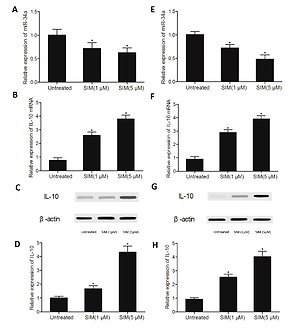Current issue
Archive
Manuscripts accepted
About the Journal
Editorial office
Editorial board
Section Editors
Abstracting and indexing
Subscription
Contact
Ethical standards and procedures
Most read articles
Instructions for authors
Article Processing Charge (APC)
Regulations of paying article processing charge (APC)
HEPATOLOGY / RESEARCH PAPER
Administration of simvastatin halts progression of cirrhosis via up-regulating expression of miR-34a and interleukin-10 in rats
1
The Second Affiliated Hospital of Xi'an Jiaotong University, China
Submission date: 2020-08-02
Final revision date: 2020-11-16
Acceptance date: 2020-12-18
Online publication date: 2021-03-28
Corresponding author
KEYWORDS
TOPICS
ABSTRACT
Introduction:
Simvastatin (SIM) treatment has been found to be able to reduce the expression of miR-34a, and we found that interleukin-10 (IL-10) is a potential target gene of miR-34a by searching the online microRNA (miRNA) database. Furthermore, it has been shown that IL10 up-regulation could halt the progression of cirrhosis. The objective of this study was to explore the underlying mechanism of Simvastatin/miR-34a/IL-10 involved in HBV associated cirrhosis.
Material and methods:
Real-time PCR, western-blot analysis, immunohistochemistry, computational analysis, luciferase assay was carried out to explore the underlying mechanism of miR-34a involved in HBV associated cirrhosis.
Results:
SIM treatment dose-dependently decreased the levels of miR-34a while increasing the levels of IL-10 mRNA and protein. Levels of IL-10 mRNA and protein were remarkably decreased, while miR-34a mRNA level and active caspase-3 protein level was apparently increased in Cirrhosis group compared with sham group. Accordingly, SIM treatment obstructed the dysregulated miR-34a expression and IL-10 expression in cirrhosis animals. By performing computational analysis, we identified that a complementary binding site of miR-34a was located in IL-10 3’ untranslated region (3’UTR), and miR-34a reduced luciferase activity of wild-type IL-10 3’UTR.
Conclusions:
Our data also suggested that SIM may become a new therapeutic strategy for HBV-associated cirrhosis via targeting the miR-34a/IL-10 axis.
Simvastatin (SIM) treatment has been found to be able to reduce the expression of miR-34a, and we found that interleukin-10 (IL-10) is a potential target gene of miR-34a by searching the online microRNA (miRNA) database. Furthermore, it has been shown that IL10 up-regulation could halt the progression of cirrhosis. The objective of this study was to explore the underlying mechanism of Simvastatin/miR-34a/IL-10 involved in HBV associated cirrhosis.
Material and methods:
Real-time PCR, western-blot analysis, immunohistochemistry, computational analysis, luciferase assay was carried out to explore the underlying mechanism of miR-34a involved in HBV associated cirrhosis.
Results:
SIM treatment dose-dependently decreased the levels of miR-34a while increasing the levels of IL-10 mRNA and protein. Levels of IL-10 mRNA and protein were remarkably decreased, while miR-34a mRNA level and active caspase-3 protein level was apparently increased in Cirrhosis group compared with sham group. Accordingly, SIM treatment obstructed the dysregulated miR-34a expression and IL-10 expression in cirrhosis animals. By performing computational analysis, we identified that a complementary binding site of miR-34a was located in IL-10 3’ untranslated region (3’UTR), and miR-34a reduced luciferase activity of wild-type IL-10 3’UTR.
Conclusions:
Our data also suggested that SIM may become a new therapeutic strategy for HBV-associated cirrhosis via targeting the miR-34a/IL-10 axis.
Share
RELATED ARTICLE
We process personal data collected when visiting the website. The function of obtaining information about users and their behavior is carried out by voluntarily entered information in forms and saving cookies in end devices. Data, including cookies, are used to provide services, improve the user experience and to analyze the traffic in accordance with the Privacy policy. Data are also collected and processed by Google Analytics tool (more).
You can change cookies settings in your browser. Restricted use of cookies in the browser configuration may affect some functionalities of the website.
You can change cookies settings in your browser. Restricted use of cookies in the browser configuration may affect some functionalities of the website.



